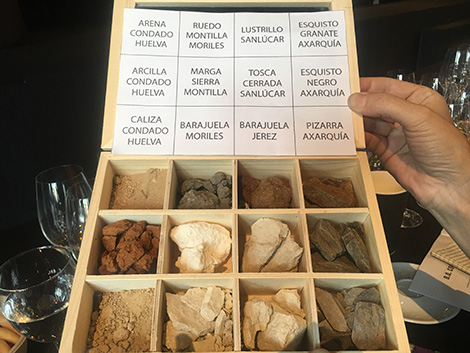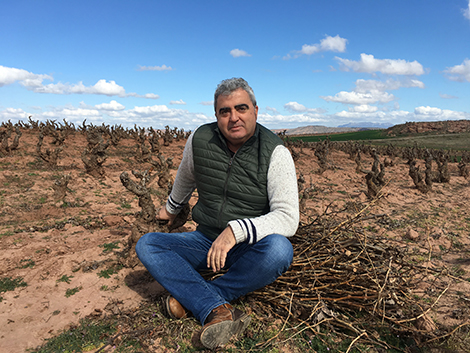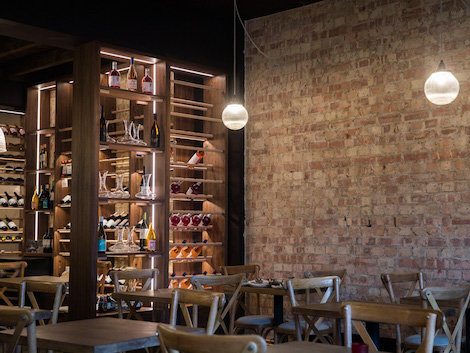
Taking into account our country's individualistic character, it was worthy of praise to see the Andalusian appellations (Jerez-Xérès-Sherry, Montilla-Moriles, Málaga and Condado de Huelva) joining forces to highlight their traditional wines at an intense three-day congress at the Círculo de Bellas Artes in Madrid.
The event combined a variety of tastings with some thought-provoking presentations and the usual concessions to the regulatory boards and reflected the current state of the wine industry with its ups and downs, as well as the outstanding yet complex styles of wines produced in southern Spain.
The harsh truth
Traditional wines have a significant weight in the Andalusian wine sector. According to data provided by Rafael del Rey, director of the OEMV (Spanish Wine Market Observatory), fortified and white wines with DO labels (finos and manzanillas with 15% vol. are included in this section) represent 41% of Andalusian exports by volume and 70% by value. But the setbacks they have experienced in recent years are alarming. Between 2000 and 2018, over €30m were lost in exports (from €100.3 to €66.3m) and half of the volume (from 41.2 to 20.2m litres). Behind the euphoria of #Sherry-Revolution, #FlorPower and #Sherrylovers lies a harsh reality.
The challenge of adding value to Spanish wines in order to promote their quality and preserve the country’s diverse, unique wine heritage is particularly pressing in Andalusia. Many of its wines, with similar or longer ageing times than a Rioja Grand Reserva, are sold at rock-bottom prices, specially in foreign markets where the dominant style, Cream, is far from the region’s flagship quality wines. In Spain, the reliance on the local market is high: 48% of fortified wine is consumed in Andalusia, said Del Rey.
The growing enthusiasm for Andalusian wines among wine lovers and sommeliers, who are increasingly including them in wine pairing menus, represent a niche market with no incidence in these macro figures.
The wines, first and foremost
Many speakers like Evaristo Babé, president of the Brandy de Jerez Regulatory Council, and merchant Ramón Suárez Coalla agreed that these wines should no longer be considered as special products —they are wines like any others. In Coalla's portfolio, dry fortified wines are placed next to standard whites; only sweet wines are considered as a separate category. How long will it take for the best dry wines form southern Spain to be placed on their own right among the country’s greatest whites?
To judge by the numerous “copitas” still used at tastings and as merchandising, there is still a long way to go.
Terroir as the catalyst for change
It is remarkable that in a forum such as this, very obvious issues still need to be pointed out. Eduardo Ojeda from Valdespino, one of the few bodegas in Jerez that still makes single-vineyard sherries featuring the names of the pagos on the labels, started his intervention stating that traditional wines are made from grapes and that yields and the age of the vines are as relevant as in any other wine.
The showroom held in parallel with the congress featured a sizeable number of bodegas from southern Spain, few of which own vineyards; most of them buy wines or, at best, grapes from suppliers. We tasted two fabulous old wines from a producer in Condado de Huelva who admitted having uprooted their last Zalema vines to plant international red varieties.
In contrast, a terroir-driven approach is in tune with the search for authenticity and distinctiveness that prevails in today’s markets. Willy Pérez (Bodegas Luis Pérez) and Ramiro Ibáñez (Cota 45), the producers behind a small revolution in the Sherry Triangle, conducted one of the most inspiring tastings of the congress. They advocated for the historic crus in Jerez and Montilla, as well as for a traditional climate zoning in other Andalusian regions. Ibáñez summed up the spirit when he said that “zoning brings added value to wines.”
The relevance of the vineyards in Andalusia was also discussed in a round table on the history and origins of these wines. The mid 18th century cadastre of Marqués de la Ensenada mentioned grape growing areas, some of them of great importance, such as Málaga. With 112,000Ha of vineyards divided into early, mid and late-ripening areas, the region had over 6,000 wine presses handling 70,000 arrobas (791,000 kg) of wine.
Historically, not only have the vineyards been classified by quality, but also the wines, explained sherry expert and scientist Álvaro Girón. Until Pasteur discovered the effect of yeasts on wine, failure rate was high; hence the wines were constantly classified. "The system of criaderas and soleras was used to put order to something dangerous from a commercial point of view", explained Girón, who also talked about the importance of bringing science into the wineries. "Technicians managed to control randomness, but nobody has yet told their story. Now we need finance and a young person to research it.”
The invisible presence of unfortified wines
Although the focus was on traditional wines, the new trend towards unfortified wines in Jerez, young whites from Montilla or dry whites in Malaga were mentioned in several occasions. In fact, Jesús Barquín from Equipo Navazos asked for a less strict framework regarding maximum (22% vol.) and minimum (15% vol.) alcoholic degrees, a measure that, in his view, would eventually lead to accept unfortified wines in the Sherry appellation. The fact that yeast (flor) can develop below 15 degrees of alcohol supports this argument.
Barquín, who pioneered this style with his partner Eduardo Ojeda with their Navazos Niepoort, pointed out some interesting characteristics of unfortified wines with flor: they express terroir, provide quick, direct information on vineyards and soils and allow young producers to enter the market in a similar way that grower champagnes reinvigorated their entire region.
In Montilla-Moriles, finos reach 15% vol. naturally, without adding any alcohol, and lower-alcohol tinaja wines are accepted by the DO. We tasted some interesting young tinaja whites made in large cement or clay vessels. This style is another example of what Rafael del Rey called a “gateway to the area” in order to alleviate the gloomy sales figures. Meanwhile, Ramón Suárez Coalla was positive that this type of wines will eventually lead consumers to traditional wines.
Beyond oxidative and biological ageing under flor, varieties from southern Spain like Palomino, Pedro Ximénez and Zalema compensate their neutral aromas with an ability to express terroir in young wines. The so-called “albariza wines” fit the needs of proactive sommeliers and of the most dynamic markets. The same can be said of lesser known styles or varieties like dry Moscatel and Pedro Ximénez produced in Malaga's rugged hills with distinctive schist soils. Perhaps the somewhat unfortunate tasting of Moscatel wines from Andalusia would have been more engaging if his conductor, Telmo Rodríguez, had been able to add more terroir-driven wines.
How and what to communicate
Communicating the complex traditional wines from Andalusia is also a major challenge.
Coalla argued that nothing has ever been achieved by drawing explanatory charts of the criadera and solera system. The intricate, tricky categories and mentions of sweet Malaga wines that producers Clara Verheij (Bentomiz) and Vicente Inat (Filitas y Lutitas) tried to describe in their tasting were challenging even for professionals. The wines spoke better for themselves.
Sommelier and consultant Lucas Payà showed that basic information can be attractively presented to modern markets eager for information like the US. Sherry is seen there as a rare classic with countless food-pairing possibilities and as a versatile ingredient in cocktails. Payà also said that styles like single-vineyard, unfiltered, vintage or very old (VORS) sherry do not overwhelm consumers; on the contrary, they help to keep the interest alive.
Ramiro Ibáñez and Willy Pérez also favour complexity but in their case, the focus is on terroir complexity (soils, grape varieties, climate…). From their point of view, understanding southern wines requires making several trips to the area and understanding different concepts; information “never ends,” they said.
Looking to the future with confidence?
Following three intense days of tastings and presentations, no one can remain indifferent to the quality, diversity and distinctiveness of Andalusian traditional wines.
It was César Saldaña, director general of the Sherry Regulatory Board, who delivered the closing speech at the congress with an accurate diagnosis of its problems. Quality cannot be taken for granted, argued Saldaña, adding that consumers will only pay more if they perceive such quality. He acknowledged that mass production and scale costs are meaningless in these wines and that adaptation and innovation are decisive factors. “The lowest moments in our history are associated with the relaxation of quality,” he summed up.
Master of Wine Sarah Jane Evans hit the nail on the head when she mentioned pride and self-trust as two of the key elements of a great wine. Obviously, authenticity and terroir were also on her list. As Willy Pérez said, “we have plenty of identity” but the risk, as it is often the case in Spain, has more to do with the trivialisation of styles. When everyone is talking terroir all over the world, this remains a pending issue at least in the Sherry Triangle. Not because it isn’t there, but because the vineyard has ceased to play the central role it once did.
A COMPREHENSIVE APPROACH TO ANALUSIAN WINES
Following their celebrated tasting on the vineyards and soils of the Sherry Triangle at Vinoble 2018, Ramiro Ibáñez and Willy Pérez prepared a similar tasting, but this time covering the whole of Andalusia. Beyond the wines, the most notable aspect of their presentation was the way they connected the history of the wine regions in Andalusia.
Their vinous journey started in Manzanilla, a village in the province of Huelva, the most famous wine region in Andalusia between the 15th and 17th centuries. As the Port of Moguer became locked, the area lost importance in favour of Sanlúcar. Sanlúcar gained provincial status between 1804 and 1808 as it controlled territories from Rota to the river Guadiana including the villages that currently form part of the DO Condado de Huelva. It is no surprise that Sanlúcar wines adopted the style of Manzanilla.
According to Ibáñez, the style that Sanlúcar inherited was a fine wine that gained concentration over time. In contrast, amontillados from Córdoba, which were later replicated throughout Andalusia, followed the opposite route: their initial concentration gradually became more refined.
At the end of the 18th century, Montilla specialized in Pedro Ximénez and biological ageing. While the oldest soils are found on Sierra de Montilla, Moriles Alto has similar soils to those on the Sherry Triangle.
In Jerez, Pérez and Ibáñez distinguished between the coastal area, stretching from Sanlúcar to Chiclana, and the inland vineyards around Jerez de la Frontera. While the coastline is suitable for biological ageing, inland areas champion oxidative ageing.
They also revealed a fascinating connection between Cádiz and Málaga. The pajarete, a famous sweet wine from Sierra de Cádiz which is named after the vineyard it came from, still survives in Málaga as one of its many sweet specialities.
At its height of splendour, Málaga grew over 100,000 hectares of vines and had a reputation for “expensive, high quality wines”, the pair pointed out. The rugged, historical Axarquía region also boasts a long-standing raisin tradition, hence the extended practice of not touching grapes and handling them gently. Yields are extremely low here and mechanisation is impossible. They think that the classification outlining early, medium and late-ripening areas, drafted by Cecilio García de la Leña in 1792, still works well in the region.
They also suggested a village-based designation for Condado de Huelva and championed the historic crus in Jerez and Montilla.
“Andalusian genetics are the result of a mixture of cultures,” Willy Pérez and Ramiro Ibáñez said in their conclusions. “Knowledge has been traditionally shared in the region” adding that the wine industry needs to reach “new levels of knowledge”.
A critical view of the congress
It is not easy to organise a three-day meeting with four Regulatory Boards that are used to working separately and often with commercial interests at odds with each other. Generally speaking, the logistics of the event ran smoothly, but we would like to highlight a few points:
An attractive programme. Technical advisors Juancho Asenjo and Paco del Castillo outlined a comprehensive set of solid, insightful presentations and round tables. As far as they could, they programmed very topical questions and used their great knowledge of Andalusia to organise attractive tastings. The one in partnership with José Ignacio Santiago Hurtado centered on Montilla-Moriles was particularly unique, memorable and entertaining.
Where were all the women? With the exception of the British Master of Wine Sarah Jane Evans, who presented the inaugural paper, and Clara Verheij, from Bodegas Bentomiz, who conducted the Malaga wine tasting together with winemaker Vicente Inat, we were surprised by the absence of women in keynote tastings and speeches -four out of over 30 speakers, according to our estimates. A lost opportunity to provide a contemporary image of Andalusian wine.
More prominence for lesser-known areas. With its rich history and relevance, Jerez undoubtedly casts a long shadow. Other regions were well represented in the tastings, but in most presentations speakers talked mostly about Sherry and, to a lesser extent Montilla. I think it is fair to say that most of us professionals lack knowledge of some of these areas, particularly Málaga and Condado de Huelva. Luckily, the congress helped us to discover interesting wines from both regions.
However, some opportunities were missed, such as the tasting of Condado de Huelva wines conduced by Manuel Infante, president of the Regulatory Board. Rarely recently has this area had the eyes, ears and noses of so many wine professionals, yet our glasses were filled with the (three) official (and anonymous) wines of the Regulatory Board instead of featuring the few producers who strive to produce traditional quality wines in the area.
Little discussion. Adjusting speaking times is always complicated, but we missed an exchange of ideas with the audience. As well as the round tables, presentations such as those by Jesús Barquín or César Saldaña on the future of Andalusian wines could have been enriched by the comments of the audience.
One day less? With the prospect of becoming a biennial event, it makes sense to reduce the congress to two days -the experience was as fantastic as exhausting albeit mitigated by the fact that presentations were held in the morning and tastings in the afternoon.
Additional reporting by Yolanda Ortiz de Arri.

Amaya Cervera
A wine journalist with almost 30 years' experience, she is the founder of the award-winning Spanish Wine Lover website. In 2023, she won the National Gastronomy Award for Gastronomic Communication
Where to drink Spanish wine in London
NEWSLETTER
Join our community of Spanish wine lovers






